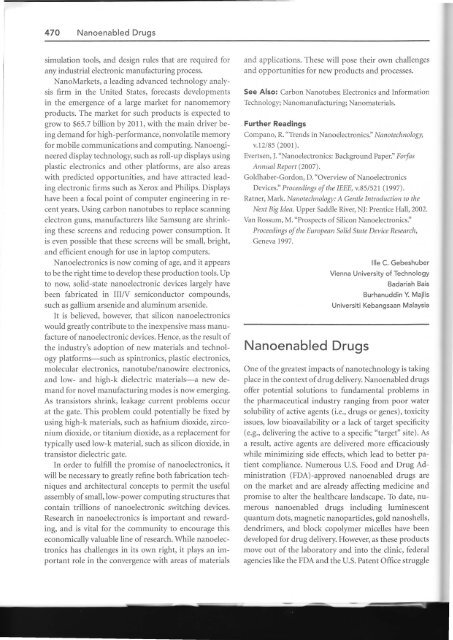nanoscience and society - IAP/TU Wien
nanoscience and society - IAP/TU Wien
nanoscience and society - IAP/TU Wien
Create successful ePaper yourself
Turn your PDF publications into a flip-book with our unique Google optimized e-Paper software.
470 Nanoenabled Drugs<br />
simulation tools, <strong>and</strong> design rules that are required for<br />
any industrial electronic manufacturing process.<br />
NanoMarkets, a leading advanced technology analysis<br />
firm in the United States, forecasts developments<br />
in the emergence of a large market for nanomemory<br />
products. The market for such products is expected to<br />
grow to $65.7 billion by 2011, with the main driver being<br />
dem<strong>and</strong> for high-performance, nonvolatile memory<br />
for mobile communications <strong>and</strong> computing. Nanoengineered<br />
display technology, such as roll-up displays using<br />
plastic electronics <strong>and</strong> other platforms, are also areas<br />
with predicted opportunities, <strong>and</strong> have attracted leading<br />
electronic firms such as Xerox <strong>and</strong> Philips. Displays<br />
have been a focal point of computer engineering in recent<br />
years. Using carbon nanotubes to replace scanning<br />
electron guns, manufacturers like Samsung are shrinking<br />
these screens <strong>and</strong> reducing power consumption. It<br />
is even possible that these screens will be small, bright,<br />
<strong>and</strong> efficient enough for use in laptop computers.<br />
Nanoelectronics is now coming of age, <strong>and</strong> it appears<br />
to be the right time to develop these production tools. Up<br />
to now, solid-state nanoelectronic devices largely have<br />
been fabricated in III/V semiconductor compounds,<br />
such as gallium arsenide <strong>and</strong> aluminum arsenide.<br />
It is believed, however, that silicon nanoelectronics<br />
would greatly contribute to the inexpensive mass manufacture<br />
of nanoelectronic devices. Hence, as the result of<br />
the industry's adoption of new materials <strong>and</strong> technology<br />
platforms-such as spintronics, plastic electronics,<br />
molecular electronics, nanotube/nanowire electronics,<br />
<strong>and</strong> low- <strong>and</strong> high-k dielectric materials-a new dem<strong>and</strong><br />
for novel manufacturing modes is now emerging.<br />
As transistors shrink, leakage current problems occur<br />
at the gate. This problem could potentially be fixed by<br />
using high-k materials, such as hafnium dioxide, zirconium<br />
dioxide, or titanium dioxide, as a replacement for<br />
typically used low-k material, such as silicon dioxide, in<br />
transistor dielectric gate.<br />
In order to fulfill the promise of nanoelectronics, it<br />
will be necessary to greatly refine both fabrication techniques<br />
<strong>and</strong> architectural concepts to permit the useful<br />
assembly of small, low-power computing structures that<br />
contain trillions of nanoelectronic switching devices.<br />
Research in nanoelectronics is important <strong>and</strong> rewarding,<br />
<strong>and</strong> is vital for the community to encourage this<br />
economically valuable line of research. While nanoelectronics<br />
has challenges in its own right, it plays an important<br />
role in the convergence with areas of materials<br />
<strong>and</strong> applications. These will pose their own challenges<br />
<strong>and</strong> opportunities for new products <strong>and</strong> processes.<br />
See Also: Carbon Nanotubes; Electronics <strong>and</strong> Information<br />
Technology; Nanomanufacturing; Nanomaterials.<br />
Further Readings<br />
Compano, R. "Trends in Nanoelectronics." Nanotechnology,<br />
v.12/85 (2001).<br />
Evertsen, J. "Nanoelectronics: Background Paper." Forfas<br />
Annual Report (2007).<br />
Goldhaber-Gordon, D. "Overview of Nanoelectronics<br />
Devices:' Proceedings of the IEEE, v.85/521 (1997).<br />
Ratner, Mark. Nanotechnology: A Gentle Introduction to the<br />
Next Big Idea. Upper Saddle River, NJ: Prentice Hall, 2002.<br />
Van Rossum, M. "Prospects of Silicon Nanoelectronics."<br />
Proceedings of the European Solid State Device Research,<br />
Geneva 1997.<br />
Nanoenabled Drugs<br />
IIle C. Gebeshuber<br />
Vienna University of Technology<br />
Badariah Bais<br />
Burhanuddin Y. Majlis<br />
Universiti Kebangsaan Malaysia<br />
One of the greatest impacts of nanotechnology is taking<br />
place in the context of drug delivery. Nanoenabled drugs<br />
offer potential solutions to fundamental problems in<br />
the pharmaceutical industry ranging from poor water<br />
solubility of active agents (i.e., drugs or genes), toxicity<br />
issues, low bioavailability or a lack of target specificity<br />
(e.g., delivering the active to a specific "target" site). As<br />
a result, active agents are delivered more efficaciously<br />
while minimizing side effects, which lead to better patient<br />
compliance. Numerous U.S. Food <strong>and</strong> Drug Administration<br />
(FDA)-approved nanoenabled drugs are<br />
on the market <strong>and</strong> are already affecting medicine <strong>and</strong><br />
promise to alter the healthcare l<strong>and</strong>scape. To date, numerous<br />
nanoenabled drugs including luminescent<br />
quantum dots, magnetic nanoparticles, gold nanoshells,<br />
dendrimers, <strong>and</strong> block copolymer micelles have been<br />
developed for drug delivery. However, as these products<br />
move out of the laboratory <strong>and</strong> into the clinic, federal<br />
agencies like the FDA <strong>and</strong> the U.S. Patent Office struggle

















